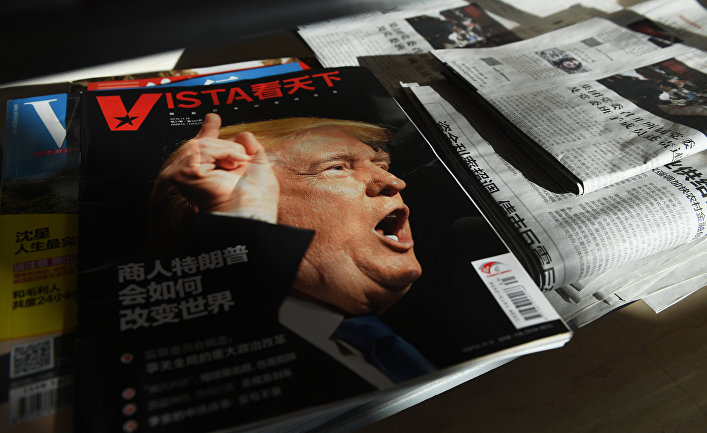
Never before has the US economy and China was not so interdependent as it is today. Never has the value of their bilateral trade and investment relations was not higher. Never still fragile state of the global economy did not demand mutual respect the US and China more than it requires now. However, given the fact that Donald trump came to power in the United States on a platform of nationalism and protectionism, the likelihood that relations between the two countries will slide into a destructive trade war, has never been higher than it is now.
Friction in these bilateral relations have always been. For many years they were sharpened, then smoothed out, however, the leaders still managed to control the situation and prevent serious crises. Over the past eight years, relations between the US and China experienced increasing pressure, requiring great patience and restraint from Washington and Beijing. The governments of both countries have imposed trade restrictions, but they tried to do so in accordance with the generally accepted rules of international trade.
The election of impulsive trump, who consider the trade competition or game in which there can be only one winner, makes the restraint is unlikely due to the way his character and at the same time strategically illogical. Because the US has a huge negative trade balance with China, President trump believes Beijing more dependent party in this relationship, that is, the party that much more to lose through a trade war. Since, from the point of view of the tramp, the effects of trade wars for the US will be relatively mild, such a course seems to him a very realistic option. This view represents a sharp rejection of the trade policy which the US has taken the last 80 years.
Threat looks trump on the economy did not appear out of nowhere. The tendency of many Americans to more strident, protectionist “America first” in relation to trade — especially trade with China — was formed and was growing the last few years. In society it is widely believed that the unfair economic policies of China and the weak U.S. reaction to the policy became the immediate cause of the loss of jobs in American industry. This view is held primarily by those who suffered the most in financial terms. These people believe that China “cheated the system” to become stronger at the expense of America, and now he’s challenging global economic and strategic dominance of the United States. Today more than ever people often openly expressed their regret about the US decision to move closer to China in economic terms and to allow China to enter the global trading system without any serious commitments. Although the election trump makes a trade war with China is highly probable this condition of bilateral economic relations is the culmination of a long and inexorable slide into the abyss.
The long road to a trade war
After the tragic events in Tiananmen square in 1989, the administration of President George H. W. Bush decided that it would continue to pursue a policy of rapprochement and cooperation with China. At that time, the volume of bilateral trade between the U.S. and China amounted to 17,6 billion dollars, and foreign direct investment were common. However, the potential economic benefits from expanding trade and increasing the volume of investment was evident, therefore, enhanced cooperation — as many then argued — more likely to boost economic and political liberalization in China than policies aimed at punishment and exclusion of this country. In addition, it was thought that sanctions would harm rather Chinese people, not the government, and at the same time would deprive European companies of new opportunities for business development.
Over the next 20 years, U.S. policy toward China was based on the idea that these economic relations are very promising and need to be supported and developed, not paying attention to the serious disagreements between Washington and Beijing on such issues as the protection of human rights and geopolitics. Trade and the economy was inviolable priority items, so the more provocative themes receded into the background.
In the first half of this period, the Chinese Central government and provincial authorities conducted a variety of market reforms to liberate the economy and enable China to meet all requirements for accession to the world trade organization. By the time in 2001 when China joined the WTO, the volume of bilateral trade rose to 121.3 billion dollars, and the volume of investments — up to $ 12 billion. By 2008, the bilateral trade volume amounted to 409 billion dollars, and investment of 56 billion.
In just 20 years, China transformed from an agrarian, and then industrial economy into a powerful industrial center of power. The growth in trade and investment has enabled hundreds of millions of Chinese out of poverty and benefited workers, businesses and consumers on both sides of the Pacific. However, in the process, began to be a lot of tensions in relations with U.S. companies.
The economic policy of the US towards China is, in essence, represent an attempt to balance two broad interest groups. On the one hand was the American industries competing in the domestic market, and trade unions seeking to prevent the penetration of Chinese goods on the American market. Over the years, they were opposed to China was given the status of countries with “normal trade relations” with the United States, as well as against the attempts of China to join the WTO. They demanded additional duties, quotas and other measures that were supposed to smooth out their fears — real and imagined — about dubious Chinese techniques, such as dumping, subsidization, currency manipulation, intellectual property theft, forced technology transfer, and environmental pollution.
On the other hand were American multinational companies and exporters who opted for a more cautious and less antagonistic approach. They preferred a strategy of cooperation with China, as he made his way in the process of integration into the global economy. These groups opposed the policies and measures which could jeopardize U.S. access to the promising Chinese market. As arguments they have used the results of many studies conducted by economists, academics and analysts who are convinced that the readiness to develop trade with China serves the interests of American companies that use Chinese imports in their production, as well as consumers, especially those from poorer layers.
In General, the policy of the US lay these points of view: China will be gladly welcomed in the Commonwealth of Nations, and to its companies and products will be treated the same way as companies and products from other countries. But American industry will be able to refer to the legal protection instruments, both universal and specific to China, as the us government will have the opportunity to bring complaints to the policy of China to the WTO. Strategic economic dialogue (established by the administration of George W. Bush and renamed the Strategic and economic dialogue under the Obama administration) and other bilateral channels of communication at the highest level was established to discuss and resolve issues that inevitably arose in the process of trade development. In General, this formula worked well, allowing quite effectively to solve problems and not bring the situation to the extreme. However, 20 years later, in 2009, suddenly everything changed.
The U.S. economy shook an enormous financial crisis and a deep recession. The financial crisis followed by economic contraction, extremely slow recovery, persistently high unemployment, the prospect of losing huge numbers of jobs and very high level of public debt, has shaken the faith of the American public. Meanwhile, the Chinese economy continued to show almost double-digit annual growth, surpassing the United States as the world’s largest producer and exporter and catching up with America in an attempt to become the largest economy in the world. The Chinese government has officially become the largest foreign holder of us government debt, which, according to many commentators, allowed him to influence the decision-making process.
The feeling that the US and China gradually switch places, forced Chinese leaders to speak out on such issues, they chose to remain silent, criticizing the US government for financial negligence and intervening in the debate on such issues, which were relatively soft position. The tone of the public rhetoric became sharper. Relatively minor disagreements escalated into large-scale scandals, and Americans ‘ anger became more pronounced. This situation forced the US government to reconsider its position.
Many raised the issue that perhaps the best days of America is behind us. Many wondered about where the US made a mistake, and where China has made the right decision. Some politicians and pundits like Tom Friedman (Tom Friedman) from the New York Times, admired what the Chinese managed to achieve thanks to their “enlightened autocracy”, and proposed to follow the example of China in the field of industrial development. Others have come to the conclusion that the United States had shown too much tolerance in the growth period of China, and called for tougher trade rules.
Meanwhile, the American business community in China, which has long opposed harsh and hasty actions can destroy his plans for the Chinese market, began to Express concern and dissatisfaction with the strengthening of Chinese protectionism. American companies began to make a warning that market liberalization in China — which clearly manifested itself at the beginning of the last decade — had stopped and now the situation begins to develop in the opposite direction. In the annual government report, published by the American chamber of Commerce in China, a list of the main issues of 2009 included a strengthening of protectionism, lack of legal transparency, a lack of control over the observance of norms and laws, as well as apparent favoritism towards local companies. In another report, the American chamber of Commerce said about the features of industrial policy of China and about the government’s plans to create national Champions by “borrowing” of Western technology.
The publication of these reports and the reaction to them has caused changes in the attitudes within the community of multinational companies in the US. The perceived threat to American business increased, while the hopes of new opportunities faded. Pessimism increased, the optimism has lost ground, and the multinational US companies with much less enthusiasm advocated a tolerant policy of cooperation with China. This has led to a shift in the balance of interests influencing US policy toward China, and the advantage was on the side of those who advocated a more aggressive approach, which included stricter control and tougher trade restrictions. It also meant that the issues of bilateral trade could no longer be considered in isolation from the broader geopolitical picture. Now the trade disputes are further aggravated by our geopolitical reality.
Obama demonstrates the power
US trade policy toward China during the reign of Obama reflected this change in sentiment. First, President Obama was allowed to impose duties on Chinese tires in accordance with the special provision in U.S. law, which President Bush did not want to use the previous three times. This decision forced China to submit a complaint to the WTO (the complaint was not upheld), and also enter the number of reciprocal repressive trade measures against American goods, including poultry and automobiles. (The word “oppressive” was in quotes, because these measures were introduced in compliance with WTO permitted instruments of legal protection of domestic trade, but the hurry in which these measures were taken, and the verdict of the Body of WTO dispute resolution that China’s actions against U.S. poultry, contrary to his obligations to WTO members, indicate that in this case one of the motives most likely was revenge.)
US law on countervailing customs duty (a law intended to correct the effects of export subsidies by foreign governments), who previously considered not applicable to “non-market” economies, again became available for sectors of American industry, with the result that during the reign of Obama against China received a record number of unjust claims. The number of complaints against China filed at the WTO under Obama by the Office of the U.S. trade representative, has increased five times compared to the period of the Bush administration. It has become much more thoroughly test the potential of Chinese investment in the United States, blocked the proposal on acquisition of part of Chinese wind farms in Oregon and ordered one of Chinese technological companies to close American firm, which she bought shortly before. Anxiety around the threat of cyber espionage have put the Chinese technology company under the scope of the Obama administration and Congress, which went to extreme measures and banned the purchase and use of Chinese telecommunication products by government agencies in the USA.
Meanwhile, Beijing is also not sitting idle. While the Obama administration tightened control measures, the Chinese government has adopted a number of new laws affecting foreign investment, competition policy and cybersecurity. The American company quickly call these laws discriminatory. In addition, from China began to receive reports that American companies are under attack, they are forced to comply with onerous documentation requirements, that they are deprived of business opportunities and that they are forced to give commercial secrets and encryption keys.
The ongoing negotiations between the two governments on the issue of concluding a bilateral Treaty on investment, as well as negotiations between multiple governments on the issue of liberalization of trade in environmental goods and public procurement were among the few initiatives that established the possibility of a positive turn in the relationship. However, all these initiatives came to nothing lead, and pessimism within the American community of multinational companies about the political situation in China and the direction of change in the business climate in China is even stronger.
In early 2016 the typical anti-Chinese campaign rhetoric was more strident than usual. Trade policy of China has been criticized from all sides of the American political spectrum. The publication of a controversial scientific article called “Chinese shock” (The China Shock), which stated that adjustment costs for those workers who were most affected by the influx of Chinese imports in the early 2000-ies, was much larger than previously thought, has been a sobering experience for supporters of the development of trade relations with China and mobilized public opinion in support of a more aggressive approach to trade with China.
Only in 2016 the Obama administration has filed four new complaints against China to the WTO, and the Ministry of Commerce has initiated 24 new anti-dumping and countervailing cases against Chinese exporters. However, the most provocative step of all was inaction: the U.S. has not given China the status of “market economy” that should have been done within 15 years after China’s accession to the WTO. 11 Dec 2016 come, however no change in the status of China or in politics never occurred. In this regard, December 12, China initiated the WTO dispute, which, most likely, will now become the main source of tension and hostility between the two countries.
On the brink
In early 2016 the volume of bilateral investment amounted to 90 billion dollars, and the trade volume reached 600 billion dollars. But 2016 ended with the election of the President, which, apparently, does not understand what means such a degree of interdependence, and who intends to use U.S. influence to change the economic relationship with China. Many supporters of the development of trade with China in Washington that once strongly defended their point of view, now silent, apparently deciding that now was politically incorrect to talk about the benefits of U.S.-China trade, not paying homage to its American victims. Fear of the political consequences of the decision to take a position contrary to the position of President, and has become one of the causes of the decay of public discourse. It is believed that it is “not good for business” if the company name appears in one of the tweets critical of the President.
Apparently, trump is rather carefree about the prospect of a trade war with China. The impression that it had a mandate to do whatever he wants — to turn around, as someone said on one of the recent conferences. Most often, the President talked about the alleged foreign exchange fraud of China that inspired his call to impose a 45% tariff on Chinese imports. No doubt, accusations of currency manipulation are already outdated. The Chinese did not intervene in currency markets to lower the exchange rate of the yuan, more than 10 years, and in the last few years, the authorities have taken steps to strengthen its currency against the background of rapid capital flight.
In relations between the US and China, there are other sources of tensions that could provoke a slide into the abyss. Discrimination against American companies in China, favouritism in relation to public enterprises, massive subsidies to industry, intellectual property theft, cyber espionage, a more thorough check of Chinese acquisitions in the U.S., discrimination against Chinese telecommunications companies in the United States and the refusal of the US to treat China as a market economy — all that remains compelling reasons for the disagreements in the relations between the two countries. While the President trump and his advisers point to a significant trade surplus of China in bilateral trade with the United States, calling it proof of unfair trading practices, and promise to retaliate, the Chinese government is threatening to stop buying aircraft from Boeing and start buying agricultural products from Australia and Canada. Undoubtedly, the Chinese are considering the possibility to strike back on other targets, i.e. companies and industries that have influence in Congress and is therefore able to some extent to rein in the President.
However, the most concern is the fact that if you argue from the standpoint of the Chinese establishment, the President si (SIC — approx. ed.) might be beneficial to start a trade war with the United States. Given the economic growth of 6.5% (the lowest indicator over the past 25 years), dissatisfaction of the public in connection with falling of incomes, corruption and serious environmental degradation, in political terms, si can win from the rupture of relations with the United States. The Communist party and the people can stand on the side of si if he convincingly blame the United States with their economic restrictions in stagnation and the economic difficulties that could ensue. If the appeal to the national pride of the Chinese, this will give China the opportunity and the strength to endure long trade war with the USA — especially given the fact that the US continues to alienate friends and make enemies in the region.
It is ironic, but the TRANS-Pacific partnership, which is often wrongly characterized as an anti-China initiative, China offers much more incentives to follow the rules of global trade than any other tool at the disposal of the American legislators. The TRANS-Pacific partnership is open to new members who are able to perform it quite stringent requirements. Many countries in addition to the 12 initial members — lined up to get in there, and began to carry out a variety of reforms in which they are partly motivated by the fear to be left out and powerless to observe how the partnership acquires supply chains and investments. No doubt that China was interested in joining the TRANS-Pacific partnership in the prescribed manner and, perhaps, even hoping for a name change to something like “free trade Area of the Asia-Pacific region.” However, the influence that the United States could eventually use to resolve long-standing and emerging tensions in the relations with China, was rejected by President trump, who in the first week of his reign, took the decision to withdraw from TRANS-Pacific partnership.
Whilst mainstream of international trade rules remain intact, so the worst violations — the adoption of protectionist measures unilaterally, is still condemned and prevented. If the country will continue to apply to the WTO for the settlement of their disputes and to rely on the system of “legal instruments to protect domestic trade”, this will reduce the probability of a trade war. But now, when the US President declares readiness to win such wars, and when the Chinese government promises not to give up their positions, the inevitable outcome is only a matter of time.
As in the case of personnel of the crash ride in slow motion, we can only observe that we have coming, powerless to change anything. Facts don’t matter anymore. Nobody wants to think about it carefully. We can no longer hope that reason and common sense will prevail. Devices-cheek rails and stop-cocks, which in the past prevented the collapse, completely out of order. And we can only fall into the abyss.







